 Today’s rock bottom Bill DesBarres moment is brought to you the letters “B and S.” Yes, since this is a post about DesBarres there is always going to be some conventional “BS” involved, but coincidentally or not, that’s the name given to Bill’s appaloosa breeding operation in Alberta – “BS Appaloosa Partners. “ Looking at this page is like looking at the interwebs circa 1995 via the Wayback Machine – it’s that outdated. Bill asks “where did 2008 go?” I too can’t believe it has come and gone. So have 2009, 2010, and 2011.
Today’s rock bottom Bill DesBarres moment is brought to you the letters “B and S.” Yes, since this is a post about DesBarres there is always going to be some conventional “BS” involved, but coincidentally or not, that’s the name given to Bill’s appaloosa breeding operation in Alberta – “BS Appaloosa Partners. “ Looking at this page is like looking at the interwebs circa 1995 via the Wayback Machine – it’s that outdated. Bill asks “where did 2008 go?” I too can’t believe it has come and gone. So have 2009, 2010, and 2011.
I know nothing about appy lines, but Bill is probably another one of those breeders who needs a “floor” in order to move his merchandise. Oh wait, we in Canada have a “floor,” and the current meat prices at OLEX (Ontario Livestock Exchange) the week this blog post was written varied from $.05 per pound to $.58 per pound. So that means your average 1,000 lb horse is currently selling for anywhere from $50 to $580.
If you’re selling a horse you bred for less than $1,000, you’re probably not recovering what you spent on breeding and raising that horse to a young age, excluding any training you’ve put on your animal, and therefore your “operation” is unsustainable. Pro-slaughter proponents in the US conveniently forget that everything costs more in Canada too – it costs more to produce, pay for supplies, pay for veterinary services, etc. Few breeders calculate in advance what it will cost them to breed and raise a yearling. As a result, even yearlings are often sold at a substantial loss or, at best, at a very modest profit. So while this will give you some beer money for the short term, it hardly represents this “wonderful option” Bill keeps regurgitating for our listening and reading pleasure.
Anyway, circling back to DesBarres – that same Equine Resource publication that was the focus of the previous blog has
offered up an article on the slaughter debate deeper within the magazine. In this article, Bill makes it seem as though happy horses trot directly into the slaughterhouse, all while complaining that the influx of American horses is hurting our meat prices due to oversupply. Now while more horses were slaughtered in Canada since the cessation of slaughter in the US, we have to ask – has the price for horses gone up? Have irresponsible owners, animal cruelty, or abandonment disappeared? And most importantly, have the prices for Bill’s appys also gone up during that time? We know he slaughters them too, because he told us so in the Spooning and Forking radio show.
He claims that a result of the US ban, more Canadians are eating horsemeat, which is available in specialty stores. Of course this is just something he pulled out of the air, since he doesn’t offer any independent source for his claims – why would Canadians eat more horsemeat BECAUSE OF the cessation of slaughter in the US?. Bill, you’ve got some s’plaining to do here. The vast majority of Canadians don’t consume horsemeat anyway – it’s a regional specialty in Quebec and some other small markets. He’s also butt-hurt since some of the major chain stores in Canada also attempted to provide horsemeat but were discouraged from continuing due to the reaction from the animal activist element. What about the consumers at the stores? Is there a chance they just weren’t interested in eating horses? Gotta blame everything on activists though.
I’m tired of Bill DesBarres attempting to demonize welfare advocates anyway. Most people who advocate for animals aren’t actually “activists” as he claims. Activism is associated with taking a vigorous stand, and surely Bill and Slaughterhouse Sue Wallis would like to convince everyone that activists are also anarchists. This is not the role of most activists, and generally most people would describe activisim of any sort as being synonymous with positive attributes rather than lawlessness. Without activism, many people would have lost their rights or been marginalized; as it is there are not enough activists to uphold all of our current rights. As a testament to his paranoia, Bill has his Linkedin profile locked down tight to avoid all those animal activists getting any classified info out of it. I guess he wouldn’t accept my invitation to connect either. No worries, he’s only got two connections, one is probably Sue Wallis and the other is Olivier Kemseke. Rather surprising for someone involved in an “international” equine business association. So that you don’t all rush to look at Bill’s profile and overwhelm him into believing that the animal activists are storming the LinkedIn castle, I’ve included a snapshot of it here.
Activists exist largely because our civil servants, who are responsible for safeguarding animals and supervising the inputs into the food chain, do so in a questionable or disrespectful manner towards their own citizens and those of countries to whom we export foodstuffs. Alex Atamanenko, MP for BC Southern Interior, and author of Bill C-322 to end horse slaughter in Canada, has said that “It is irresponsible for Canada to allow the sale of meat from horses as a food item when they have never been raised in accordance with the food safety practices required for all other animals.”
Bill DesBarres never mentions drugs in this article. Why would he? Both he and Sue Wallis don’t want anything to impinge on their slaughter empire. In the article, Bill writes that:
- “The slaughter business for the purpose of producing meat for human consumption has been subject to increasing regulations, scrutiny, technical development, improved humane handling, and increased logistical costs since the commencement of the industry.”
In practice however, little of this is enforced, so as to make DesBarres claims almost meaningless. The Federal Health of Animals Act is not enforced, which would protect sick, pregnant and unfit horses, and prohibit overcrowding; the Recommended Code of Practice for Care and Handling of Farm Animals: Transportation of Horses. is not enforced. The CFIA does not enforce their own weak rules that slaughter bound horses must not be transported for longer than 36 hours straight and must be provided with feed, water and rest at required intervals. Double-decker trailers are still allowed in Canada. Horses are shipped in crowded trailers over long distances, and often arrive injured, sometimes fatally. Horses, unlike most livestock, do not travel well. So, suffice it to say, they don’t always respond well when being transported from kill auctions in the U.S. to federally licensed slaughterhouses in Quebec and Alberta. Since 2007, inspectors have been banned from the kill floor for their own safety, since the adoption of firearms has been implemented to stun animals, so their role is basically an administrative one now. So how could inspectors intervene when humane incidents have occurred, as revealed by a CBC probe?
I am sure most readers of this blog and other writings on abuse of horses in slaughterhouses have been made aware of the
undercover investigations inside horse slaughterhouses in Canada, revealing serious food safety and horse welfare concerns. These GRAPHIC videos all prove that the requirements set out by the government for food safety and horse welfare ALL failed disgracefully. This raises several concerns:
- Has the worker who stuns horses multiple times in these videos received proper training to render the horses insensible?
- If he is properly trained and using these international humane assessments then has the employee realized that he needs to administer one or several more stuns to achieve the correct degree of unconsciousness that he has been trained to look for?
- If this is the case, it would strongly suggest that there is a problem with the captive bolt gun or this method is not meeting international humane standards.
- If he has been trained properly to administer the stun and the horse is indeed unconscious then does he just continues to stun the already unconscious horse for some sort of personal pleasure?
None of these scenarios are acceptable, and the position of the camera has no relevance, as claimed by the CFIA. It is quite clear that horses are stunned more than once with one horse stunned ELEVEN times making this facility NON-COMPLIANT, no matter what angle you view it from.
DesBarres also offers this:
- “In 2011, the Horse Welfare Alliance of Canada (HWAC) introduced the first industry audit for horse processing plants. The meat industry is subject to audits by the government for food safety, humane transport and handling, and audits by buyers to assure product quality for their customers. “
I’ve never heard of this audit, and he doesn’t tell us where it can be found either. Is this really the first industry audit? If so, I have to ask what the $^@)%*& has the CFIA being doing before DesBarres came up with his own document? More importantly, who, if anyone, is using it? The CFIA do have their own audits, which don’t seem to accomplish anything, although recently they acted responsibly by playing a role in admonishing a kill buyer from the US who sent a Phenylbutazone/Clenbuterol contaminated horse through the food supply. Doesn’t matter, because the reality is that the humanity of slaughter and transport haven’t improved. To me, it’s like asking if you can create a more humane rape, as a transition to “humane rape” (please no one write that I’m trivializing rape either). There is quite a bit of evidence available that refutes these naive claims.
European Union inspectors will be coming to Canada for an audit of horsemeat facilities if they have not already come and gone. They will be primarily concerned with dangerous levels of Phenylbutazone (PBZ/Bute), an anti-inflammatory commonly used for pain relief on horses, which has shown up in a series of tests over a five-year period. Phenylbutazone is of course banned from use in animals intended for human consumption in Canada, the U.S., the U.K. and the EU. The drug is referenced in the CFIA’s E.5 List of Veterinary Drugs Not Permitted For Use in Equine Slaughtered for Food with Canadian Brand Name Examples (10 March, 2010). All of the products listed carry an indication for use in equine (but not equine intended to be slaughtered for food).
Of course, that hasn’t stopped Canada from exporting it and relying on the EU to catch our testing errors and omissions. Additionally, a recent Toronto Star Investigation revealed that:
“A 2010 U.S. study on animals sent to slaughter found the presence of a particularly troubling drug commonly administered to horses — Phenylbutazone (PBZ), an anti-inflammatory used for pain relief. The drug is banned for human consumption by the U.S., Canada, U.K. and European Union because of documented health hazards, sometimes fatal, including a blood disorder in which the body’s bone marrow doesn’t make enough new blood cells and a condition that triggers chronic bacterial infections. The study’s researchers found 9,000 pounds of meat from horses “with known exposure to PBZ sent for human consumption over the five-year study period.”
“There appears to be inadequate testing to ensure that horses given banned substances such as PBZ do not enter the  slaughter pipeline,” the study concludes. “The lack of oversight to prevent horses given PBZ from being sent to slaughter for human consumption … indicates a serious gap in food safety and constitutes a significant public health risk.”’ The EU also confirms that even a miniscule amount of the metabolites of PBZ can cause disease, including aplastic anemia – I wonder how HWAC’s “audit” deals with the shipping of drug-laden horsemeat to the EU?
slaughter pipeline,” the study concludes. “The lack of oversight to prevent horses given PBZ from being sent to slaughter for human consumption … indicates a serious gap in food safety and constitutes a significant public health risk.”’ The EU also confirms that even a miniscule amount of the metabolites of PBZ can cause disease, including aplastic anemia – I wonder how HWAC’s “audit” deals with the shipping of drug-laden horsemeat to the EU?
There is no disputing the fact that horses are purchased at auction and often end up at slaughter with in a week’s time, many direct from race tracks. The race horse industry spends upwards of $50 million dollars a year to ensure horses are not over the accepted drug limits on race day the same way they do with human athletes. It is well known that race horses receive drugs banned from the human food chain, including Phenylbutazone, Viagra, Lasix, and even “frog juice” – Dermorphin. Why is the Canadian government risking the health of humans by accepting these horses for slaughter? Race horses can easily be identified by their lip tattoos. Yet the government turns a blind eye to this tainted meat being sold for human consumption. However, everyone else is catching up to the fact that we are shipping tainted meat.
From the article:
- “In reality, horse slaughter is an option that could potentially put an end to much abuse and neglect of horses, and solve the problem of what to do with the unwanted horse.”
Horse Welfare Organizations wonder why breed associations continue to reward millions of dollars in breed incentives each year, while refusing to use some of that money as funds for horse rescues, funds for gelding, and funds for humane euthanasia. To me, that would be a logical place to start reducing the numbers of those “unwanted horses. The public is fed up with the lack of action by those in office who could stop this. Pro-slaughters generally do not want to discuss this, as it infringes on their right to do what the hell they want. Their toolbag is full of dirty tricks, doing a total disservice instead of focusing on true solutions. They do not want to draw attention to the never-ending vicious cycle of over-breeding and they generally have no input regarding the imminent litigation due to the immoral implementation of toxic meat posing a public health risk.
Bill now winds up the article with a peppering of paranoia for anyone who isn’t yet convinced that activists are going to ban animals in Canada:
- “We are very fortunate in Canada that our citizens have the opportunity and the right to own animals”
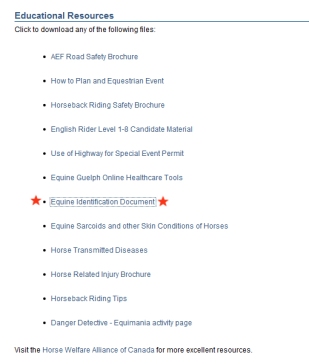
Alberta Equestrian Federation EID – conveniently provided just in case their “Welfare” programs aren’t all that helpful.
Is he serious? Who does he think is working to remove the rights of Canadians to own animals? This is more of that “don’t infringe on my right to abuse animals” and “property rights paranoia.” Canada is a world-leader in equal rights, and I’m justifiably proud of the constitutional framework we have created to protect equality. But I’m truly embarrassed to be Canadian when it becomes apparent that we do not have the ability or desire to protect animals from abuse and cruelty. Animal cruelty elicits a strong response from most Canadians, and it is time to extend that response to the protection of Canadian and American horses, who should never be part of the food chain.
HWAC has no real horse welfare programs, if they were genuinely concerned about horse welfare, DesBarres would not try to discredit video evidence. That speaks volumes. What they and the International Equine Business Association (with Sue Wallis) ARE trying to make happen is a form of permanent identification and traceability for horses and to that end, has contracted with Animal ID Solutions Inc., a Canadian company with operations in the United States.They also plan to utilize Animal ID Solution’s Global Animal Identification Network.
Microchipping for horses was to be the next step after the EID system. The chip is supposed to integrate with other national and international traceability programs. Of course, Animal ID Solutions are going to have global contacts internationally with other RFID-type programs, which certainly suggests that the IEBA, HWAC, Equine Canada, and DesBarres have got to keep this slaughter machine moving full-speed ahead so they can take it all global and find replacement markets for the EU, if they are no longer interested in our “product” after 2013. For United Horsemen’s part, I wonder where they think they will get the money to do this? Weren’t they having trouble refunding registration fees for the cancelled Summit of the Horse and the truck raffle for a truck that never existed?
More on the topic of Equine Canada, export markets, ID programs in a subsequent blog post……..
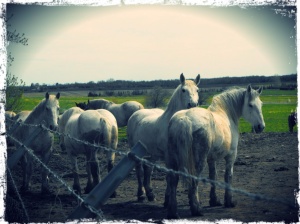


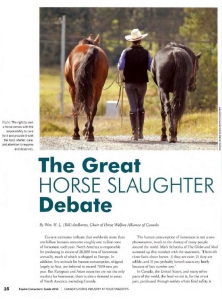
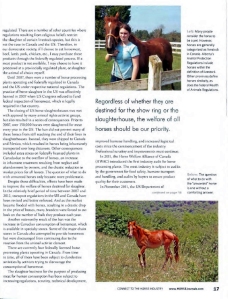
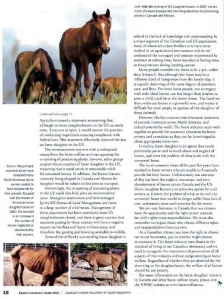

Pingback: The Irony; It Burns! Bill DesBarres Still Busy Whitewashing Horse Slaughter | Canadian Horse Defence Coalition's Blog
Thank you for this very informative and truthful article.
Thanks for reading Kate!
The entire discussion re horses from the slaughter scammers revolves around how to kill useful healthy horses and rip off taxpayers and host countries.
There is no reason for horse slaughter and every informed person knows that.
The entire discussion with these con artists has to be reframed into “What prosecution is appropriate for the attempted business frauds committed by Wallis and friends in various states in the U S?” All have failed, by the way.
How do we get reimbursed for the thefts, frauds, court time, crimes, law enforcement costs, infrastructure damages, highway accident costs, state vet compensation, lost taxes of 123 million a year for welfare ranchers in western states (Cattlemans Assoc etc), costs to owners for recovering stolen horses from ripoff auctions, federal inspections costs due to killer buyers/sellers and their attempted ripoffs, state costs for lost business as a result of the former presence of kill plants (Cavel and Dallas Crown), increased crimes which states had to investigate and resolve as a result of kill plant presence–I think we had best look at the entire lost income and costs of the horse slaughter scam and make sure that prosecutions for all the crimes and for the lost dollars be assigned to the usual suspects. They are responsible for their own acts. They need to reimburse us.
How about we reframe the useless conversation we are having with Wallis and her ilk like DesBarres into how we get paid back for their transgressions. That would be more enlightening and helpful.
The U S Congress is responsible for making sure they act ethically and pass bills the nation demands. Some members have blocked humane legislation due their need for illicit funding and so, need to be removed by voters.
The Congressional Ag Committee needs to be removed for lack of ethics. Taxpayers need to reimbursed for lost tax dollars.
We don’t need to kill any equines. We need to be reimbursed. Attempted fraud needs prosecution. We need to stop wasting time on a discussion about how to kill work partners and pets who bring income and joy to many people.
Live horses generate income and always have. Everything else is a lie.
These notorious slaughter scam artists are simply liars and need to be removed from any contact with taxpayer dollars or animals. They absolutely should not be permitted to hold any elected office in any state.
We are letting them determine how we talk and what we talk about. There is too much talk and too little action in regards to removing these con artists from office and from any rescue or humane organization.
There are slaughter scam supporters in horse rescues, horse organizations, breeding organizations, agriculture, Congress, lobbyist organizations, horse dealers & uncontrolled auctions. If they support horse slaughter, they support crime. It is that simple.
Let’s stop playing their game of death for cash.This is an easy topic to decide if facts are known.
This is an excellent blog and I am glad to see this topic pursued by a good writer.
In addition to everything you’ve written, I feel that we must be vigilant in demanding that abusers and thieves be punished appropriately – apparently it takes a lot of phone calls to get the wheels of justice rolling. Where appropriate, lawsuits will work too. I’m not familiar with the angle of law that might be applicable, but I would like to see something precedent-setting happen with regard to people knowingly receiving stolen animals for slaughter, and for slaughterhouses for not performing “due diligence” in making a reasonable attempt to check for stolen horses. We’ve recently seen a hint of that coming down the pipe with the USDA warning letter to Andio for supplying a drugged-up horse that came up to Canada. People trolling Craiglist for free horses and making misrepresentations about themselves need to be charged with fraud or via the tort system. Unfortunately for many people this is the only language they understand.
Exactly! I have been periodically scanning for a legal case which could serve as a precedent. These cases in which an aka or a misrepresentation of a purpose is used seem to fall under the heading of fraud, generally speaking. (I am not an attorney).
Think Kelsey Lefever in PA, in which she misrepresented herself as a rescue and was in fact, found to be lying to horse donors in order to send those horses off to slaughter and for pay. On the face of it, that seems to be a fraudulent transaction. She went to court and beat that rap due to what I assume is the usual corruption in PA. (PA has a lot of issues with animal abuses and puppy mills, etc. So does Ohio.)
This case was not about slaughter being OK or not. That is not the issue here. The problem rests with the lie which started it all and what transactions were accomplished after that initial misrepresentation. There is a dollar value involved with those horses, which was lost. A donor signs over a horse or other animal which has a dollar value and an emotional value which was supposed to be understood by all parties. The dollar loss alone should prompt attention by an investigative agency. In business, this kind of false pretense involved in any transaction seems to be fraud.If it is found to be fraud, it should be prosecutable in a court of law.
The action of any party in a transaction is done under certain terms. Whatever is written as the contract between parties is supposed to exist as the agreement at the time of signing. What is written on that contract is crucial to any prosecution or legal remedy if one party acts in a way which is not agreed upon at the time of signing. Unless there is a process for verifying or remedying a default by one party or the other, then the agreement is meaningless later on. With no process for challenge, no enforcement is possible. A fraud is then more easily accomplished. There would be no lasting consequence to that activity.
If any agreement stated,”Kelsey Lefever is to take a horse and take care of it” and nothing else, then Kelsey did nothing wrong under that understanding. As long as slaughter exists, she is not guilty of anything and she “took care of the horse” by selling it to slaughter. The fact that she sold these horses secretly and it was found later on and after the fact would seem to me to indicate that she had promised otherwise. That would seem to be significant enough to inquire as to Kelsey’s credibility in every way. Still, no prison sentence for this horse killer in racing. As far as I know, Kelsey Lefever can go back to operating in racing. (Anyone want to operate any biz in PA after this?)
In any agreement what is written is all you have when it comes to enforcement later. Whatever remains verbal and not in writing is subject to question and lack of verification later. Liars get by in court as long as there is no witness to any verbal misrepresentation. Don’t we all know that anyone who lives by lies will continue to?
The importance of a Kelsey Lefever is that any misrepresentation without documentation made about intent to acquire anything of value can get a pass in court. Essentially, fraud is Ok. That is the message I got from reading about that case. Contracts which may have existed in that case are unknown to me and I have no idea if anyone signed anything before they handed away rights to their beloved horses. If there had been a legal agreement signed which would have held up in a court challenge, Lefever could perhaps have been prosecuted for fraud and maybe she could have been sent to do time. That would be meaningful in terms of bringing accountability even if an anti-slaughter law does not exist.
The need for a legal precedent remains an issue. I have never found one online that seems adequate to mention as useful. Without legislation on the books which is standard in every state and with means of enforcement, these violators may be hateful but face no real consequence in court for their actions. Then we see the use of federal agencies try to bring enforcement actions for different reasons and at taxpayer expense.
We are paying taxpayer dollars for these slaughter corps and then paying again to deal with the criminal activity their unethical operators cost us every day on our highways and in other unethical business operations here in the states. It takes the DOT and the USDA (FDA) to bring attention to killer buyers and operators like a Ron Andio (Ohio) or a Leroy Baker (Ohio). State tax dollars are being wasted and federal tax dollars are being used because foreign owned slaughter profiteers are using us as the host and not even paying taxes. The example of outrageous costs to Kaufman TX and Mayor Paula Bacon by Dallas Crown (see series on slaughter by Vickery Eckhoff in Forbes) is a great example of what happens when these slaughter corps bully their way into small towns and then destroy it. Eventually, the EPA had to be used to get rid of Dallas Crown. Those were federal tax dollars used, again.
Slaughter is costing all of us. Without a national anti-slaughter law, there is no way to reliably prevent damages from slaughter operators. We can’t recoup on our losses in tax dollars and of course, from the loss of our loved ones. A legal precedent which can be used from state to state would really help.
Anyone who makes any agreement with any party to take possession of permanently and care for any horse has to have that agreement vetted by a competent attorney and sign with witnesses present. That may slow down or even prevent outrageous abuses or slaughter later on.
Obviously, any legal precedent has to be just right in order to be used later on for related cases. It has to stand up to challenge under various circumstances. Minus any national anti-slaughter law, these frauds will continue as they are now.
What does it tell us about the effect of special interest lobbying funds that Congress will not hear debate about passage of S1176? Certain members of the political community are dedicated to keeping that slush money from foreign owned slaughter corps coming in.
This is a very important step in fighting these slaughter operators as long as we lack national law. An international agreement which had teeth for enforcement would be ideal.
Thank You for another comprehensive article, You hit the nail on the head each & everytime!
Thank you Kathy……..
They have no idea about how much their `rights’ will be infringed on if Canada and US come into complete compliance with the EU regulations. If they don’t, there will be next to no slaughter. Period. Maggot Des Barres is very well programmed by the Slaughterhouse Sue. They will defend any animal abuse as their `rights’. They don’t have a right to abusive and inhumane. If anything the general public are far less tolerant of these things now. It’s called `progress’ and `enlightenment’.
Kinda related, but I found this very old article about the asshat in Calgary that was packaging horse meat as `beef’ about 10 yrs ago. I remember this because I was up there racing at the time and there was an uproar. http://www.explodingcigar.com/article587.html.
Wow – “Jay’s Supermarket in Calgary, Canada has been fined over $80,000 for selling horse meat labeled as beef. The grocery store argued they thought the meat they had been buying was beef, not horse. It is suspected the store may have sold horse meat for years before being caught.” Too bad there is no mention of their supplier. I assume that the hefty fine results from them having the carcasses on premises and therefore knowing full well the difference between a horse and a cow. No mention of their supplier being fined though.
Pretty gross huh? I was up there racing horses at the time and I remember that on the news. Thank God I had never shopped at that place.
Now that IS bad! Especially with horses most likely being contaminated with dangerous substances. Ewwwwww!
Many years ago a burger chain called Jack-N-the-Box was caught selling kangaroo meat as beef in their burgers. I’ll spare you all the Jumping Jack jokes.
How would they get kangaroo meat? It’s quite a detour from Australia to the US after all…………you wouldn’t think they’d normally import it to the US, or that it would be more expensive that using the meat they’d normally put into their food. Stuff like this is also why I quit eating meat – it’s pretty much all “mystery meat” in the end – chicken nuggets, Spam, Salisbury steaks, sausages, and hot dogs are all a “mystery…….”
Pingback: The Irony; It Burns! Bill DesBarres Still Busy Whitewashing Horse … | Stop Horse Abuse
Pingback: Puttin’ on the Ritz (Crackers) « heatherclemenceau
Pingback: Supporter Finds Contradictions in Horse Welfare Alliance Article | Canadian Horse Defence Coalition's Blog
Looked up the story about Calgary Butcher and guess what, fines were cut in half here is a link to that article http://foodsafety.k-state.edu/en/news-details.php?a=1&c=27&sc=221&id=30378
I took at look at his BS Appaloosa web page as well. Notice on the ‘for sale’ page the weanlings are described as ‘pleasantly plump’. I guess that’s in case they don’t sell, we all know he’ll get a good price at the slaughterhouse for them.
I can’t believe you people. I would like you to know that what you have posted isn’t looking at the big picture. I am a against horse slaughter as well but you have to ask yourselves where do the horses come from. They come from all over Canada by horse breeders, I urge you to look at some breeders web pages other than Bills and count how many broodmares that they have in their possesion. You will see that other horse breeders have way more broodmares sometimes up to forty mares and more. I think it would be more important to talk about how we can minimize the number of mare being breed in a single given year. If you are so worried about horse slaughter you have to go too the foundation and that is the horse breeders. I have know Bill for most of my life and i can tell you first hand that your acusation of selling his “pleasantl plump weanlings” to a slaughter house is rediculous beacuse i am a proud owner of one of those weanlings, Sweetnohing. Another thing how can you say “No worries, he’s only got two connections, one is probably Sue Wallis and the other is Olivier Kemseke” without further investigation, clearly you have no idea who his connections are. I believe that you should be looking at the bigger picture not just focusing on one thing. I have done lots of research into this topic cause I did a presentation on it for 4-H an have come up with some good ideas on how we can slowly decrease the amounts of horses being sent to slaughter. If you have any questions on what i have just said or for varification just reply.
Bill himself has said and is quoted in several articles I have screen capped here that he doesn’t euthanize any of his old horses – they all go to slaughter. He has said that he considers euthanasia to be “cruel,” which of course I do not comprehend. How can something that we do for our pet dogs and cats be cruel for horses? Naturally he did breed and sell some – did you think I mean that he produced only meat horses? Bill is featured here in this blog numerously because he is the person behind the Horse Welfare Association of Canada – a PRO SLAUGHTER organization. I don’t think you have done any research into HWAC though, or you would understand why Bill is featured here so frequently. I feature Bill quite a bit in my blog posts because he claims that the undercover slaughter videos that the Canadian Horse Defence Coalition features on its blog and website are “fake.” This is not true. The RCMP validated the video take at the Bouvry slaughter plant in Alberta as authentic, yet Bill still claims it has been faked.